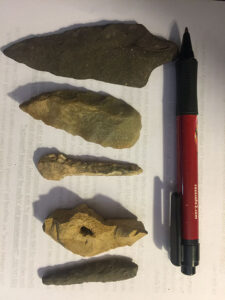 LS inherited a small collection of Native American points and tools. He believes them Southwestern in origin. This is not my area of expertise so this article serves as a call to readers to HELP LS to find out about his treasure. So, if you know Native American points and tools, please email me or comment below.
LS inherited a small collection of Native American points and tools. He believes them Southwestern in origin. This is not my area of expertise so this article serves as a call to readers to HELP LS to find out about his treasure. So, if you know Native American points and tools, please email me or comment below.
Archeologists separate the classifications of early points into major historical periods of North America. I learned with rudimentary research that each of the periods contain points of distinctive shapes, stones, and sizes. The sizes, archeologist say, indicate the mammals hunted…some going back over 10,000 years.
Two Methods of Dating
One, the “BC” style, but lately archeologist use the “BP” time period. The difference? BP is termed “before present” time, set at 1950.
Let me explain the time periods using the BP system. When we look at stone points in the Native American tradition from 11,500 to 10,800 BP they call it the Early Paleoindian era. Theses points appear large and the famous name for this form they call the CLOVIS point. Designed for a spear the blade has channels down the center. If you think of mammals hunted for protein over 10,000 years ago, they needed large and deadly points to pierce the hide.
The middle Paleoindian, 10,500 to 10,000 BP, continued to see large points. Around 10,000 BP archeologists note a change to smaller points with flared bottoms, which Native Americans lashed to something other than a large spear, for smaller game. They gave them the big name “Dalton” point. In the early Archaic period, 10,000-8000 BP, the point shape changes to the more classic image of an arrowhead. In other words we see the shape of a triangle supported on a “trunk” or stem. The stem, straight or hooked, makes it perfect for lashing to a hunter’s wood shaft.
The next period saw multitudinous cultures. LS believes his points came from the Southeastern region, I assume this the Woodland culture 1000 BP to 1500 AD. This era is followed by the Contact period 1500 to 1700 AD.
Sheer Artistry of Native American Points
The sheer artistry of the stone tools themselves impresses me greatly, not to mention the durability and diversity. Some reports said archaeologists found a point created as a spear, and when dulled and sharpened again Native Americans made it a saw. Then when blunted they made it a scraper. They never wasted anything they created.
LS, who loves his collection, said when he holds an ancient, over 10,000 years old, point in his hand, he “sees” the mammals the points aimed at. He also sees the skill of both the point maker and the hunter. Around 12,000 years ago Native Americans may have used these points to hunt mammoths, mastodons, bison, ground sloths, sabre toothed cats, and short faced bears.
One Stone Point in LS’s Collection
This is in fact not a projectile but a stone drill. LS’s collection also includes a fragment of a petrified stone rock with a bore hole, and the drill fits nestled inside this hole. They may have used an organic (wooden) helper to turn the device manipulated by cords, pulled by human hands that rotated the drill rapidly. It served as a fire starter.
Another point in LS’s collection may have been a small scraper, used to flense a hide.
The rate of change and the shape and innovation in the stone tools especially in flint forms show incredible workmanship and diversity of form. The collection includes knives, used alone or on a wood handle, scrapers, perforators, drills, adzes, stone axes, and stone weights they used to attach to nets and to the end of spear throwers as fulcrums.
LS also sent photos of what he researched as an early Archaic Notched Point, perhaps 10,000 years old, and an Agate point of even a greater age.
I reach out to readers who assuredly know more than I do, to email me or comment below, so I may connect you, an expert, to LS. As regards to the valuation of this material, who am I to set a value of such things.
Pingback: McKenney Preserved History of Tribal Leaders - Elizabeth Appraisals